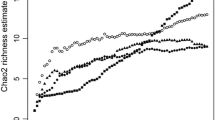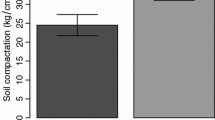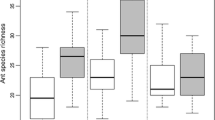Abstract
Wood ants (Formica spp.) were hypothesised to affect the composition and greatly reduce the abundance of large-sized soil fauna by predation. This was tested in two ways. Firstly, a 4-year-long experimental study was carried out in a mixed forest. Five ant-free 1.3-m2 plots were created by fenced exclosures within an ant territory. Five nearby plots had fences with entrances for the ants. In addition, five non-fenced control plots were selected. Soil fauna (e.g. Coleoptera, Diptera larvae, Collembola and Araneae) was sampled during the summers of 1997–2000. The soil fauna was affected by the exclosures but there was no detectable effect of ants on the soil fauna. Secondly, soil fauna was studied within a large-scale natural experiment in which the long-term (30 years) effects of red wood ants could be assessed inside and outside ant territories. This long-term natural experiment revealed no significant effects of ants on the abundance or composition of soil fauna. The results from the two studies indicate that the effects of wood ants on soil fauna are fairly small. The hypothesis that wood ants are key-stone predators on soil fauna could, thus, not be supported.





Similar content being viewed by others
References:
Begon M, Harper JL, Townsend CR (1986) Ecology: individuals, populations and communities. Blackwell, Oxford
Bengtsson J, Zheng DW, Ågren GI, Persson T (1995) Food webs in soil: an interface between population and ecosystem ecology. In: Jones CG, Lawton JH (eds) Linking species and ecosystems. Chapman and Hall, New York, pp 159–165
Bengtsson J, Lundkvist H, Saetre P, Sohlenius B, Solbreck B (1998) Effects of organic matter removal on the soil food web: forestry practices meet ecology theory. App Soil Ecol 9:137–143
Bengtsson J, Engelhardt K, Giller P, Hobbie S, Lawrence D, Levine J, Vilà M, Wolters V (2002) Slippin' and slidin' between the scales: the scaling components of biodiversity-ecosystem functioning relations. In: Loreau M, Naeem S, Inchausti P (eds) Biodiversity and ecosystem functioning: current knowledge and future challenges. Oxford University Press, Oxford, pp 209–220
Berg M (1993) Sleuteltabel kevers. In: Van Veen M, Zeegers T (eds) Insekten basis boek. Jeugdbondsuitgeverij, Utrecht, pp 45–65
Brauns A (1954) Untersuchungen zur angewandten Bodenbiologie, vol.1. Terricole Dipterenlarven. Musterschmidt Wissenschaftlicher, Göttingen
Brüning A (1991) The effect of a single colony of the red wood ant Formica polyctena on the spider fauna (Araneae) of a beech forest floor. Oecologia 86:478–483
Cherix D, Bourne JD (1980) A field study on a super-colony of the red wood ant Formica lugubris Zett. in relation to other predatory arthropods (spiders, harvestmen and ants). Rev Suisse Zool 87:955–973
Clarholm M (1985) Possible roles of roots, bacteria, protozoa and fungi in supplying nitrogen to plants. In: Fitter AH, Atkinson D, Read DJ, Usher MB (eds) Ecological interactions in soils. Blackwell, Oxford, pp 355–366
Diamond J (1986) Overview: laboratory experiments, field experiments, and natural experiments. In: Diamond J, Case TJ (eds) Community ecology. Harper and Row, New York, pp 3–22
Fjellberg A (1980) Identification keys to Norwegian Collembola. Norsk Entomologisk Forening, Norway
Folgarait P (1998) Ant biodiversity and its relationship to ecosystem functioning: a review. Biodivers Conserv 7:1221–1244
Gilyarov MS, Krivolutskii DA (1975) A key to the soil-inhabiting mites sarcoptiformes. USSR Academy of Sciences, the AN Severtsov Institute of Evolutionary Morphology and Ecology of Animals, Zoological Institute, Moscow
Gridina TT (1990) Influence of Formica polyctena Foerst. (Hymenoptera Formicidae) on the distribution of predatory arthropods in forest ecosystems. Mem Zool 44:21–36
Haemig PD (1994) Effects of ants on the foraging of birds in spruce trees. Oecologia 97:35–40
Halaj J, Ross DW, Moldenke AR (1997) Negative effects of ant foraging on spiders in Douglas-fir canopies. Oecologia 109:313–322
Hassell MP, Southwood TRE (1978) Foraging strategies of insects. Annu Rev Ecol Syst 9:75–98
Hölldobler B, Wilson EO (1990) The ants. Springer, Berlin Heidelberg New York, pp 419–420
Inozemtsev AA (1974) Dynamics of the food relationships of common red ants and their role in regulating the abundance of noxious invertebrates in oak forests of the Tula district. Sov J Ecol 5:252–262
Karhu KJ (1998) Effects of ant exclusion during outbreaks of a defoliator and sap-sucker on birch. Ecol Entomol 23:185–194
Karhu KJ, Neuvonen S (1998) Wood ants and a geometrid defoliator of birch: predation outweighs beneficial effects through the host plant. Oecologia 113:509–516
Laakso J (1999) Short-term effects of wood ants (Formica aquilonia Yarr.) on soil animal community structure. Soil Biol Biochem 31:337–343
Laakso J, Setälä H (1998) Impacts of wood ants (Formica aquilonia Yarr.) on the invertebrate food web of boreal forest floor. Ann Zool Fenn 37:93–100
Laakso J, Setälä H (1999) Population- and ecosystem-level effects of predation on microbial-feeding nematodes. Oecologia 120:279–286
Laakso J, Setälä H (2000) Impacts of wood ants (Formica aquilonia Yarr.) on the invertebrate food web of boreal forest floor. Ann Zool Fenn 37:93–100
Laine KJ, Niemelä P (1989) Nests and nest sites of red wood ants (Hymenoptera Formicidae) in Subartic Finland. Ann Entomol Fenn 55:81–87
Lenoir L (2002) Can wood ants distinguish between good and bad patches on the forest floor? Eur J Soil Biol 38:97–102
Lenoir L, Persson T, Bengtsson J (2001) Wood ant nests as potential hot spots for carbon and nitrogen mineralisation. Biol Fertil Soils 34:235–240
Littell RC, Milliken GA, Stroup WW, Wolfinger RD (1996) SAS system for mixed models. SAS Institute, Cary, N.C.
Moore JC, Walter DE, Hunt HW (1988) Arthropod regulation of micro- and meso-biota in below ground detrial food webs. Annu Rev Entomol 33:419–439
Naeem S (2001) Experimental validity and ecological scale as criteria for evaluating research programs. In: Gardner RH (ed) Scaling relations in experimental ecology. Columbia University Press, New York, pp. 223–250
Niemelä J, Hailo Y, Halme E, Pajunen T, Punttila P (1992) Small-scale heterogeneity in the spatial distribution of carabid beetles in the southern Finnish taiga. J Biogeogr 19:173–181
Nilsson SG, Bengtsson J, Ås S (1988) Habitat diversity or area per se? Species richness and woody plants, carabid beetles and land snails on islands. J Anim Ecol 57:685–704
Oliver I, Beattie AJ (1996) Designing a cost-effective invertebrate survey: a test of methods for rapid assessment of biodiversity. Ecol Appl 6:594–607
Persson T, Bååth E, Clarholm M, Lundkvist H, Söderström BE, Sohlenius B (1980) Trophic structure, biomass dynamics and carbon metabolism of soil organisms in a Scots pine forest. Ecol Bull Stockholm 32:419–459
Petal J (1978) The role of ants in ecosystems. In: Brian MV (ed) Production ecology of ants and termites. International biological programme. Cambridge University Press, Cambridge, pp 293–325
Petersen J, Hastings A (2001) Dimensional approaches to scaling experimental ecosystems: designing mousetraps to catch elephants. Am Nat 157:324–333
Polis GA, Strong DR (1996) Food web complexity and community dynamics. Am Nat 147:813–846
Puntilla P (1994) Effects of management on the ecological diversity of boreal forests. Metsäntutkimuslaitoksen Tiedonantoja 482:47–56
Reznikova ZI, Dorosheva EA (2000) Effect of red wood ants on carabid behavior: experimental studies at the individual level. Doklady Biol Sci 75:644–646
Ritchie ME, Olff H (1999) Spatial scaling laws yield a synthetic theory of biodiversity. Nature 400:557–560
Roberts MJ (1995) Spiders of Britain and Northern Europe. Harper Collins, London
Rybalov LB, Rybalov GL, Rossolimo TE (1998). Interrelations between red wood ants and litter predators in the Kostomuksha Reserve. Usp Sovrem Biol 118:313–322
Saetre P, Brandtberg PO, Lundkvist H, Bengtsson J (1999) Soil organisms and carbon, nitrogen and phosphorus mineralisation in Norway spruce and mixed Norway spruce-birch stands. Biol Fertil Soils 28:382–388
Setälä H, Huhta V (1991) Soil fauna increase Betula pendula growth: laboratory experiments with coniferous forest floor. Ecol Soc Am 72:665–671
Skinner GJ (1980) The feeding habits of the wood-ant Formica rufa (Hymenoptera: Formicidae) in limestone woodland in north-west England. J Anim Ecol 49:417–433
Skinner GJ, Whittaker JB (1981) An experimental investigation of inter-relationships between the wood-ant (Formica rufa) and some tree-canopy herbivores. J Anim Ecol 50:313–326
Sudd JH, Lodhi QK (1981) The distribution of foraging workers of the wood-ant Formica lugubris Zetterstedt (Hymenoptera: Formicidae) and their effect on the numbers and diversity of other Arthropoda. Biol Conserv 20:133–145
Swenson JE, Jansson A, Riig R, Sandegren F (1999) Bears and ants: myrmecophagy by brown bears in central Scandinavia. Can J Zool 77:551–561
Van der Aart PJM, de Wit T (1971) A field study on interspecific competition between ants (Formicidae) and hunting spiders (Lycosidae, Gnaphosidae, Ctenidae, Pisauridae, Clubionidae). Neth J Zool 21:117–126
Vespsäläinen K, Savolainen R (1990) The effect of interference by formicine ants on the foraging of Myrmica. J Anim Ecol 59:643–654
Von Sörensen U, Schmidt GH (1987) Das Beutespektrum der Waldameisen (Genus: Formica, Hymenoptera) in der Bredstedter Geest (Schleswig-Holstein) im Jahre 1980. Waldhygiene 17: 59–84
Warrington S, Whittaker JB (1985) An experimental field study of different levels of insect herbivory induced by Formica rufa predation on sycamore (Acer pseudoplantanus). I. Lepidoptera larvae. J Appl Ecol 22:775–785
Wise DH (1993) Spiders in ecological webs. Cambridge University Press, Cambridge
Acknowledgements
We thank Christer Björkman and Heikki Setälä for discussions and comments on the manuscript. The study was supported by grants from the Oscar and Lili Lamm Foundation (T.P.) and the Swedish Natural Science Research Council (J.B.)
Author information
Authors and Affiliations
Corresponding author
Rights and permissions
About this article
Cite this article
Lenoir, L., Bengtsson, J. & Persson, T. Effects of Formica ants on soil fauna-results from a short-term exclusion and a long-term natural experiment. Oecologia 134, 423–430 (2003). https://doi.org/10.1007/s00442-002-1143-x
Received:
Accepted:
Published:
Issue Date:
DOI: https://doi.org/10.1007/s00442-002-1143-x




